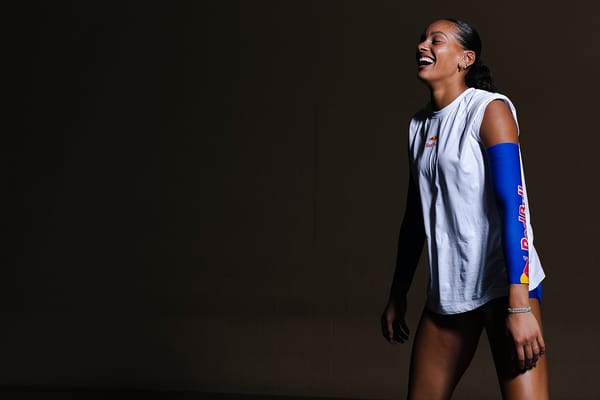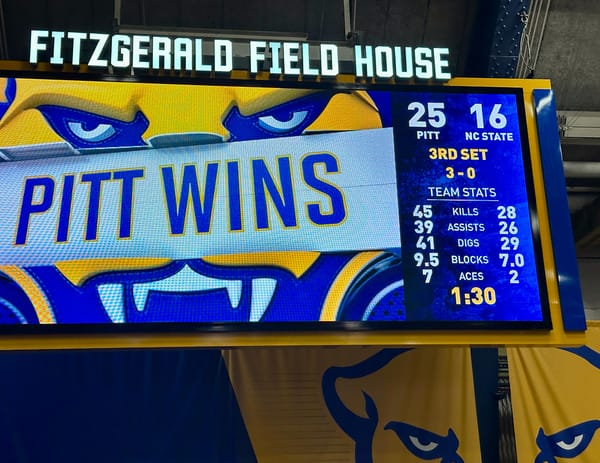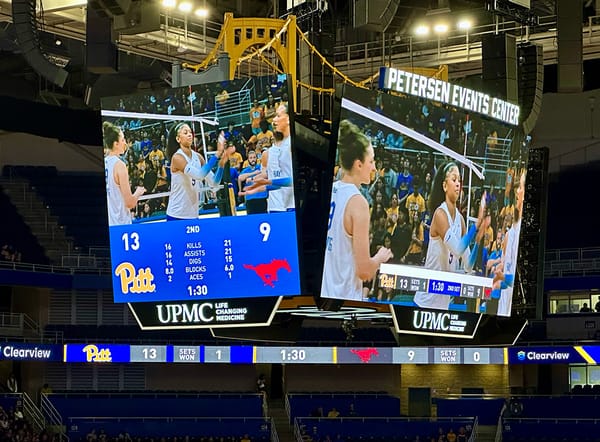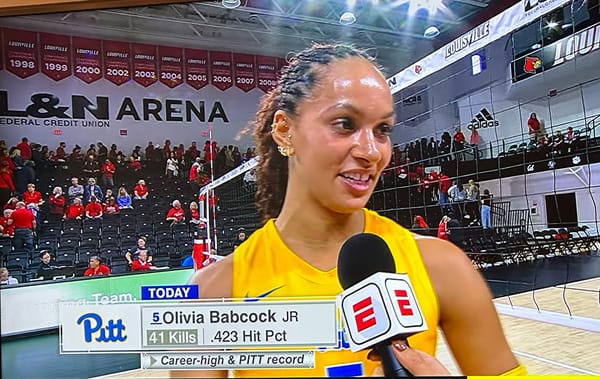One Area Where Pitt Has Room to Improve
It’s an aspect of the game that traditional stats do an insufficient job of measuring.

If you're a numbers and analytics gal or guy, volleyball's a pretty good sport for you. Each point is discrete, like tennis. There are a lot of shot attempts to track, like basketball. And a bunch of nerds are crafting metrics to measure success, like baseball.
Still, there are plenty of gaps in our ability to quantify aspects of volleyball. How do you measure the success of a setter when so much is based on the skill of the hitter to whom they're setting? How much credit should a middle blocker get for forcing an opponent into a bad swing? Should I be doing something more productive with my life? All unanswerable!
There also exist some large gaps between public stats and proprietary stats – perhaps the largest involving serve-receive or passing (volleyball folks often use the terms interchangeably, I've learned).
The public stats on passing basically measure one thing: Did you get aced when the ball was served at you? Sure, you can add up how many times the ball was served to you and then get a Reception Percentage. But that tells us precious little about your actual ability to pass the ball in a way that helps your team's attack.
The proprietary stats? Much better. The biggest subscription-based system across the game is Volleymetrics, and to my knowledge most teams will follow the 0/1/2/3 grading system for pass quality:
3 point pass: A "perfect" pass or a pass where a setter can comfortably set all three attackers.
2 point pass: A "medium" pass or a pass where a setter can comfortably set two attackers. Typically a 2-rated pass would not be easy to set your middle attacker.
1 point pass: A "poor" pass. Typically a setter only has one option on who to set and possibly no options. This is a pass that does not immediately result in an error, but the setter is not able to choose who to set.
0 point pass: A “zero” pass results in an ace for the other team.
Now we're getting somewhere! This is a much better measurement of how a player's contributions in serve-receive help her setter and ultimately her offense. Add it all up, divide by the number of attempts, and you've got a passer rating.
It's not without flaws. As volleyball analytics extraordinaire Chad Gordon has pointed out, you'd much rather have a passers consistently putting up 1-point and 2-point passes than a passer ping-ponging between 3-point and 0-point passes – even if both players would end up with an average rating around 1.5.
But the only way we get those passer ratings is if some thoughtful person with a Volleymetrics subscription would compile the numbers and publish them for us free of charge. As toxic as the Volleytalk forums can be, user jwvolley was kind enough to do that for the Top 25 of the AVCA Coaches Poll.
Unfortunately for Pitt, the numbers are not where they once were.
Last year's team was one of the best serve-receive units in the country, with libero Emmy Klika and outsides Torrey Stafford and Valeria Vázquez Gomez all averaging between a 2.2 and 2.35 passing rate. They're all gone now.
In their place, the new passers are holding their own but a notch below last year's group:
- Dagmar Mourits - Outside - 2.18 rating, 58.4% good passes, 322 attempts
- Emery Dupes - Libero - 2.14 rating, 51.7% good passes, 325 attempts
- Blaire Bayless - Outside - 2.05 rating, 48.8% good passes, 205 attempts
- Marina Pezelj - Outside - 2.01 rating, 43.9% good passes, 189 attempts
- Izzy Masten - Defensive Specialist - 1.92 rating, 43.9% good passes, 164 attempts
Another user, hopefuldawg, ran the team-wide numbers, and Pitt slotted in 16th out of the Top 25 teams in passer rating (2.09) and 17th in good pass percentage (50.7%).
Pitt is also still without Mourits, the Panthers' best passer, likely for a few more weeks. My hope would be that she could return into the back row first (a lot less jumping on an injured ankle) and provide some of that strong passing again before the end of the regular season.
Fortunately we can see at least one player getting better in the serve-receive game: Blaire Bayless has been pressed into six-rotation duty and is passing well. As Avidvolley compiled, Bayless averaged a 2.36 passer rating against NC State and Wake Forest, good enough for 9th among Power Four outsides last week:
NCAAVB Top Receiving Outside Hitters x Week 9⃣ pic.twitter.com/WyfsvlDfHe
— Avid (@AvidVolley) October 28, 2025
No matter what the passing numbers are, Pitt is ultimately still effective when the ball is being served to them. The Panthers have won 64.9% of points while in serve-receive, good for 10th in the nation (per Evollve). Clearly setter Brooke Mosher and right-side hitter Olivia Babcock are doing their jobs in generating offense, even when the passes aren't the finest.
All of this is useful because it illustrates one crucial aspect of the game where the 2025 Panthers are a notch below the 2024 Panthers – an aspect that doesn't come across clearly when you're looking at traditional stats. It also demonstrates that improvement in passing over the next month or so could be a major boost for Pitt come December for the NCAA Tournament.
I hope at some point we can get public passing metrics for college volleyball. Better information helps us shed a light on why teams win, why teams lose, and how players contribute to those results.
Serve-receive is a big part of the game, and it's worth knowing who is doing it well. I haven't paid much attention to Tennessee's Gülce Güçtekin, but apparently she's been one of the best passers across the NCAA – that's helpful to know!
Thanks to all the fellow nerds putting in the time to teach us more, even if it shows us an area where Pitt Volleyball could stand to improve. I won't take it personally.




